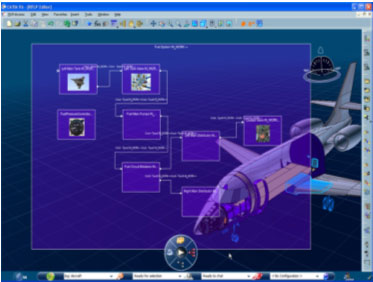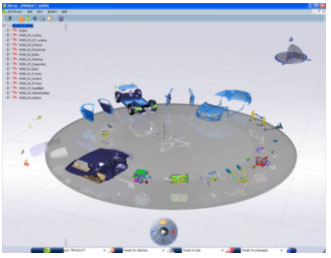Taking PLM to the Next Step

PLM 2.0, the PLM online for all, is an online environment for virtual product experience in 3D which allows everybody to see and participate in the product lifecycle. Providing PLM on line for all becomes possible thanks to V6, Dassault Systèmes’ next generation platform.
PLM 2.0 is about realizing the promise of web 2.0 - the participative web where user interactions generate knowledge - in industry. It is an environment that will make it possible for user communities to take advantage of on-line applications from anywhere to imagine, share and experience products using the universal language of 3D. As such, PLM 2.0 expands PLM to include business users and end consumers. It is based on the new V6 platform, a unified and open Web services architecture that makes it possible to develop new types of online applications allowing everybody who has a role in the life of the product to participate in designing the product with a very intuitive interface and from any where in the world.
EVERYONE CAN COLLABORATE ON A PRODUCT
With market and consumer tastes and needs varying at an increasingly fast pace, companies depend more and more on innovation to continuously bring new and better products to their customers. This requires that they maximize their intellectual capital by allowing everyone (employees and consumers as well) to participate in a product’s lifecycle from initial idea all the way to how the consumer will buy and use the product. Collaboration between the various participants on a product’s life requires a platform capable of federating all product-related knowledge, and managing easy access to it from anywhere. V6 goes as far as enabling on-line product authoring in real time from anywhere in the world with only an Internet connection.

Just picture yourself actually modeling in 3D with CATIA from your home, and in a concurrent fashion with co-workers in the office! PLM 2.0 is also about harnessing the collective intelligence of online communities such as designers, marketers, or just about any innovators. With V6, it is possible to identify co-workers of interest online, form a group in an ad-hoc fashion, share one’s work and ideas in 3D, and act as a group.
A LIFELIKE PRODUCT EXPERIENCE
Focusing on the end consumer’s experience of the product has emerged as an essential driving force when designing a product. PLM 2.0 allows the product innovation process to start with the consumer specifying his/her desired customer experience, and to end with the consumer “test driving” the future product virtually. This requires a lifelike experience: experiencing the product and its behavior just like in real life, including the shopping experience, and having a virtual product model compliant with reality: for instance, the virtual fall of a cell phone on the ground produces the exact same outcome as in reality
ONE SINGLE PLATFORM
V6 presents a wide range of growth opportunities for the ecosystem and third parties developing applications. V6 also addresses new types of users, providing a single platform spanning from multidisciplinary engineering groups all the way to enterprise business users, including users dealing with consumer profiling, marketing, etc.
The V6 platform is one environment for Dassault Système (DS) and non-DS applications. Its single PLM Enterprise Foundation provides a federated view and access to all product-related information – or Intellectual Property (IP) - whether it comes from a DS application, or from other PDMs, ERPs or even from unstructured data sources. For example, when a CATIA model is accessed, the price, which may come from SAP, is visible as well.

OPEN, AND EASY TO OWN AND USE
The V6 PLM Enterprise Foundation is an open web-services architecture which embraces the SOA (Service Oriented Architecture) standards and generalizes the use of XML. On this foundation reside native Dassault Systèmes’ applications - CATIA, DELMIA, SIMULIA and ENOVIA, as well as third party applications via the Design Data Management layer. V6 integrates all product-related activities at the data and process level: it spans from all engineering disciplines to business users. The architecture is optimized to allow remote product authoring from anywhere using a web connection. The 3D PLM User Experience, where users benefit from a common intuitive experience across all applications, brings IP to life in 3D.
Anyone can search, find, navigate all PLM information easily, and connect and interact with others in a fun-to-use 3D environment. V6 also leverages the methodologies learned in V5 by users, and it does not require retraining.
Simplicity of installation, maintenance and management, via a single server and database for all applications, dramatically reduces cost of ownership, and cuts PLM deployment time.
The flexible SOA architecture also allows easy integration with existing systems, and modeling of business process with no programming skills. Finally industry-specific solutions capture the value within each industry and provide the best and most tailored path to PLM.
EXPANDING EXISTING PLM ASSETS
Dassault Systèmes is also developing additional V5 releases and enabling smooth future transition paths to V6. As evidence of this, Dassault Systèmes released ENOVIA MatrixOne 10.8 which is compatible with V6, and supports hybrid V4, V5, V6 scenarios, allowing users to work on the same model with different CATIA versions. Dassault Systèmes also continues its commitment to small and medium businesses, and is planning to deploy an ENOVIA SmarTeam solution on the V6 platform. Customers currently using SmarTeam Design Express will all have a smooth transition to V6’s mid market offering. First customers are already experiencing the value of V6; Dassault Systèmes is working with early customers across multiple industries with a focus – for CATIA - on industrial equipment, automotive and aerospace. The V6 platform is scheduled for general availability in May 2008 with 180 CATIA, DELMIA, SIMULIA, ENOVIA, applications.
For more information, write to marketing@edstechnologies.com
